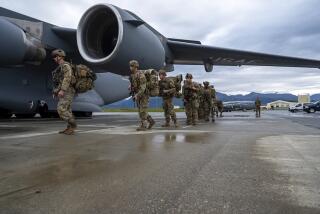U.S. Aircraft Come Between Afghan Factions
- Share via
KABUL, Afghanistan — Reflecting the seriousness of the factional violence that has racked northern Afghanistan this month, a top U.S. official revealed Saturday that American military aircraft were sent to fly over the scenes of some battles to discourage militias from engaging.
The official, who asked not to be identified, did not say what aircraft were used or how many were sent over the conflict-ridden areas, which included Meymaneh in Faryab province and a location in Samangan province.
But the official said the flyovers achieved the desired effect, helping to quell the fighting.
“They all understand where we stand, that they have to clamp down on it,” said the official. “They got the message.”
At least 21 militia members and civilians were killed during the last two weeks in clashes between units of rival warlords Abdul Rashid Dostum and Atta Mohammed. Both are national army corps commanders in President Hamid Karzai’s Ministry of Defense.
U.S. intervention between fighting warlords in Afghanistan is not unheard of, but in the past it has typically occurred when American soldiers were at risk. Late last year, a U.S. aircraft dropped a 500-pound bomb on combatants in western Afghanistan after a U.S. patrol in the area was fired on.
The fighting between northern militias has heated up just as the United Nations and the Karzai government are trying to launch an ambitious program to disarm 100,000 soldiers in the pay of the warlords.
That program, underwritten by Japan and other international donors, is a focus of efforts to replace the militias with the new Afghan army, being trained by the U.S. military with help from French army instructors. The continuing violence, however, has caused some observers to doubt whether the militiamen will give up their arms.
A week ago, a U.N.-led peace commission brokered a truce between the warring factions in Meymaneh and arranged a prisoner exchange. But on Thursday, a U.N. spokesman described the situation as still tense. The streets of Meymaneh were said to have been filled with mines and other unexploded ordnance when a U.N. team arrived there last Sunday.
The Afghan Interior Ministry sent 150 members of the nation’s newly formed national police to patrol the streets, a spokesman said.
The militias are often irregular and undisciplined holdovers from the 23 years of guerrilla warfare against the occupation forces of the former Soviet Union and later the Taliban regime. Their allegiance typically lies with regional commanders, who pay their salaries, and not with the central government.
Although it is not known what sparked the recent violence, rival commanders often spar over control of such things as customs duties, police forces and land.
After the eruption of violence, Dostum and Mohammed were quoted as saying that they did not authorize the fighting.
One nongovernmental aid organization with an operation in Meymaneh said Saturday that it withdrew its representatives and shut down operations there after a wild daylong gun battle April 8.
Word of the flyovers came on the same day that Karzai and Lt. Gen. Dan K. McNeill, U.S. operations commander, opened a two-day seminar in Kabul, the capital, on ways to integrate the old militias with the new Afghan army.
In attendance were such major regional warlords as Atta, Gov. Ismail Khan of Herat province and Gen. Mohammed Daoud of Kunduz. Dostum was scheduled to arrive, the U.S. official said.
McNeill said it has been nearly a year since the U.S. military, after the defeat of the Taliban, began helping Afghanistan “in many ways.”
“One was to help in creating a national army,” he said. “I would be less than truthful if I told you it hasn’t been a rough road.”
More to Read
Sign up for Essential California
The most important California stories and recommendations in your inbox every morning.
You may occasionally receive promotional content from the Los Angeles Times.













